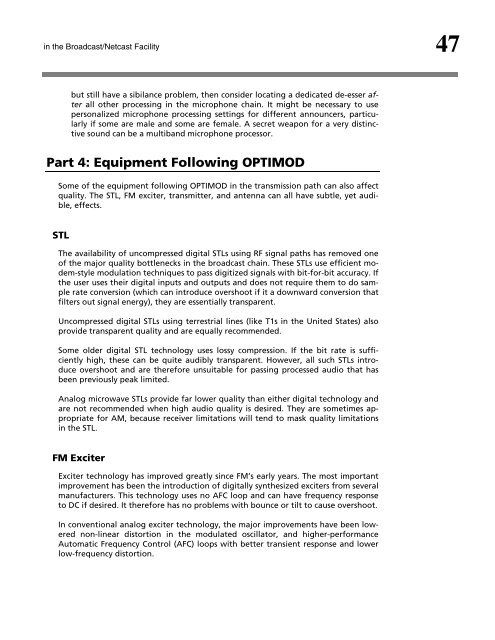Maintaining Audio Quality in the Broadcast Facility 2011 - Orban
Maintaining Audio Quality in the Broadcast Facility 2011 - Orban
Maintaining Audio Quality in the Broadcast Facility 2011 - Orban
You also want an ePaper? Increase the reach of your titles
YUMPU automatically turns print PDFs into web optimized ePapers that Google loves.
<strong>in</strong> <strong>the</strong> <strong>Broadcast</strong>/Netcast <strong>Facility</strong> 47<br />
but still have a sibilance problem, <strong>the</strong>n consider locat<strong>in</strong>g a dedicated de-esser after<br />
all o<strong>the</strong>r process<strong>in</strong>g <strong>in</strong> <strong>the</strong> microphone cha<strong>in</strong>. It might be necessary to use<br />
personalized microphone process<strong>in</strong>g sett<strong>in</strong>gs for different announcers, particularly<br />
if some are male and some are female. A secret weapon for a very dist<strong>in</strong>ctive<br />
sound can be a multiband microphone processor.<br />
Part 4: Equipment Follow<strong>in</strong>g OPTIMOD<br />
Some of <strong>the</strong> equipment follow<strong>in</strong>g OPTIMOD <strong>in</strong> <strong>the</strong> transmission path can also affect<br />
quality. The STL, FM exciter, transmitter, and antenna can all have subtle, yet audible,<br />
effects.<br />
STL<br />
The availability of uncompressed digital STLs us<strong>in</strong>g RF signal paths has removed one<br />
of <strong>the</strong> major quality bottlenecks <strong>in</strong> <strong>the</strong> broadcast cha<strong>in</strong>. These STLs use efficient modem-style<br />
modulation techniques to pass digitized signals with bit-for-bit accuracy. If<br />
<strong>the</strong> user uses <strong>the</strong>ir digital <strong>in</strong>puts and outputs and does not require <strong>the</strong>m to do sample<br />
rate conversion (which can <strong>in</strong>troduce overshoot if it a downward conversion that<br />
filters out signal energy), <strong>the</strong>y are essentially transparent.<br />
Uncompressed digital STLs us<strong>in</strong>g terrestrial l<strong>in</strong>es (like T1s <strong>in</strong> <strong>the</strong> United States) also<br />
provide transparent quality and are equally recommended.<br />
Some older digital STL technology uses lossy compression. If <strong>the</strong> bit rate is sufficiently<br />
high, <strong>the</strong>se can be quite audibly transparent. However, all such STLs <strong>in</strong>troduce<br />
overshoot and are <strong>the</strong>refore unsuitable for pass<strong>in</strong>g processed audio that has<br />
been previously peak limited.<br />
Analog microwave STLs provide far lower quality than ei<strong>the</strong>r digital technology and<br />
are not recommended when high audio quality is desired. They are sometimes appropriate<br />
for AM, because receiver limitations will tend to mask quality limitations<br />
<strong>in</strong> <strong>the</strong> STL.<br />
FM Exciter<br />
Exciter technology has improved greatly s<strong>in</strong>ce FM’s early years. The most important<br />
improvement has been <strong>the</strong> <strong>in</strong>troduction of digitally syn<strong>the</strong>sized exciters from several<br />
manufacturers. This technology uses no AFC loop and can have frequency response<br />
to DC if desired. It <strong>the</strong>refore has no problems with bounce or tilt to cause overshoot.<br />
In conventional analog exciter technology, <strong>the</strong> major improvements have been lowered<br />
non-l<strong>in</strong>ear distortion <strong>in</strong> <strong>the</strong> modulated oscillator, and higher-performance<br />
Automatic Frequency Control (AFC) loops with better transient response and lower<br />
low-frequency distortion.



![[PDF] Using the ITU BS.1770-2 and CBS Loudness Meters ... - Orban](https://img.yumpu.com/50629372/1/190x245/pdf-using-the-itu-bs1770-2-and-cbs-loudness-meters-orban.jpg?quality=85)






![[PDF] Optimod-FM Feature Comparison - Orban](https://img.yumpu.com/41741615/1/190x245/pdf-optimod-fm-feature-comparison-orban.jpg?quality=85)






